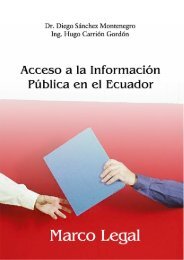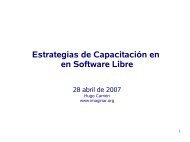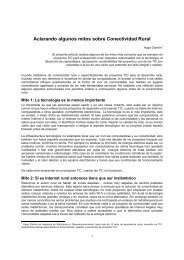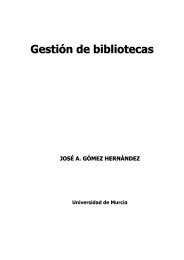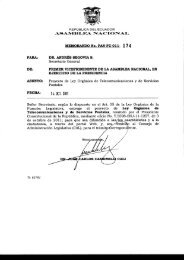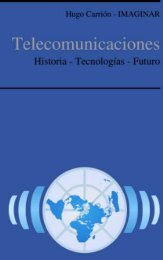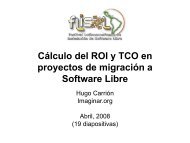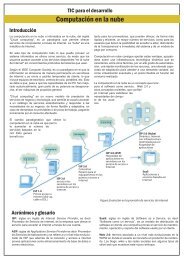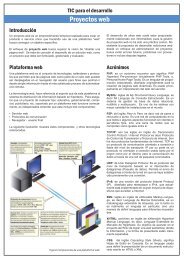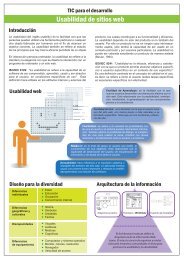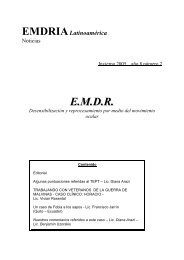GLOBAL INFORMATION SOCIETY WATCH 2010
GLOBAL INFORMATION SOCIETY WATCH 2010
GLOBAL INFORMATION SOCIETY WATCH 2010
Create successful ePaper yourself
Turn your PDF publications into a flip-book with our unique Google optimized e-Paper software.
objective of addressing key issues, such as rights to lands,<br />
territories and resources and social justice, and how the<br />
estimated 400,000 to 600,000 indigenous pygmy peoples<br />
in the DRC could be involved in the conservation efforts<br />
and benefit directly from the economic, environmental and<br />
social benefits resulting from REDD.<br />
A Climate-REDD working group was established in<br />
June 2009 by civil society. As a result of this process of<br />
engagement with representatives from Groupe de Travail<br />
Forestier, the National League of Indigenous Pygmy<br />
Organisations of the Congo (LINAPYCO), Dynamique<br />
des Groupes des Peuples Autochtones, and the National<br />
Resources Network, among others, a decree supporting<br />
REDD by establishing a National Coordination Committee,<br />
an Interministerial Committee and a National REDD Committee<br />
was approved by the Council of Ministers in October<br />
2009, with the expectation of being signed subsequently by<br />
the prime minister. 3<br />
It has been recommended that countries develop their<br />
own adaptation plans, but with the assistance of the international<br />
community made available to developing countries<br />
through initiatives such as the United Nations Environment<br />
Programme and United Nations Development Programme<br />
partnership launched in Nairobi during the climate convention<br />
in November 2006. The objective of this adaptation<br />
strategy is to provide assistance in reducing vulnerability<br />
and building the capacity of developing countries to<br />
more widely reap the benefits of the Clean Development<br />
Mechanism (CDM). This particularly in areas such as the<br />
development of cleaner and renewable energies, climate<br />
proofing and fuel-switching schemes. Following this adaptation<br />
initiative, the DRC has started its own adaptation<br />
initiative under the National Adaptation Programme of Action<br />
(NAPA). Among its actions, NAPA revealed in 2006 that<br />
DRC rural communities have identified greater intensity of<br />
rainfall and periods of extreme heat as their major concerns.<br />
Its report also revealed that they witnessed during<br />
that period primitive farms and freshwater structures being<br />
destroyed by flooding and outbreaks of disease associated<br />
with the explosion of insect populations and shortages of<br />
safe water that often occur during heat waves.<br />
Using ICTs for climate change mitigation<br />
As established in 2000, one of the UN Millennium Development<br />
Goals consists of making the benefits of new<br />
technologies – especially information and communications<br />
technologies (ICTs) – available to both industrialised<br />
nations and developing regions. Following these goals,<br />
many projects have been founded by the International Telecommunication<br />
Union (ITU), Organisation for Economic<br />
Co-operation and Development (OECD), World Wide Fund<br />
for Nature (WWF) and other organisations with the aim of<br />
looking into ICTs and climate change.<br />
3 Ibid.<br />
Despite this engagement, one of the main challenges<br />
faced by many African countries with regards to the concerns<br />
and effects of climate change lies in the uncertain<br />
predictions of climate computer models, and the lack of<br />
appropriate climate sensors to be used for accurate assessment<br />
of changes in the climate. In the case of the DRC,<br />
this might hinder consistent projections of rainfall patterns<br />
in its four separate climatic zones. Furthermore, the efficiency<br />
and role played by civil society may be reduced if the<br />
policies defined and actions planned within the context of<br />
the REDD programme are not supported by preventive actions<br />
resulting from climate data obtained using the climate<br />
sensors launched into the environment.<br />
As currently implemented, climate change monitoring<br />
is based on macro-infrastructures that use climate monitors<br />
sparsely deployed at a relatively small number of fixed<br />
locations by governmental organisations. This creates a<br />
visibility gap that needs to be addressed through complementary<br />
technologies, systems and strategies. To bridge<br />
this gap, civil society needs to use micro-infrastructures<br />
using off-the-shelf devices to extend the available climate<br />
maps by:<br />
• Collecting climate data using climate sensors<br />
• Analysing this data<br />
• Modelling climate change in cities and the whole<br />
country<br />
• Deriving sound policies based on the derived climate<br />
models<br />
• Providing awareness to citizens, official organisations,<br />
NGOs and private organisations.<br />
Actions steps: The need for participatory sensing<br />
Participatory sensing using mobile phones and sensor/<br />
actuator technologies is one of the enabler technologies<br />
which can be used to support this process due to the wide<br />
penetration of mobile phones in Africa and the emergence<br />
of general packet radio service (GPRS)-enabled sensor/actuator<br />
devices. A participatory sensing system is one that<br />
allows individuals and communities to collect, share and<br />
organise information through data collection using mobile<br />
phones and other mobile platforms, in order to make a<br />
case for change, and to explore and understand their life<br />
and relationship with the environment. 4<br />
Participatory sensing emphasises the involvement of<br />
citizens and community groups in the process of sensing.<br />
It can range from private personal observations to the<br />
4 Burke, J. et al. (2006) Participatory sensing, Proceedings of the World Sensor<br />
Web Workshop, ACM SENSYS, Boulder; Shilton, K. et al. (2008) Participatory<br />
Privacy in Urban Sensing, Proceedings of the MODUS Workshop, St. Louis;<br />
Campbell, A. T. et al. (2006) People-Centric Urban Sensing, Proceedings<br />
of the 2nd ACM/IEEE Annual International Wireless Internet Conference,<br />
Boston; Reddy, S. et al. (2007) Sensor-Internet share and search: Enabling<br />
collaboration of citizen scientists, Proceedings of the Workshop for Data<br />
Sharing and Interoperability.<br />
Democratic Republic of Congo / 115





